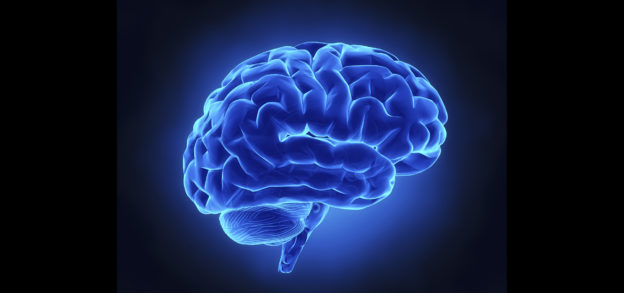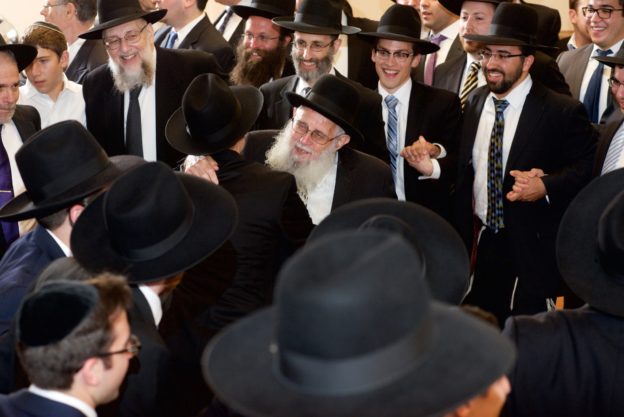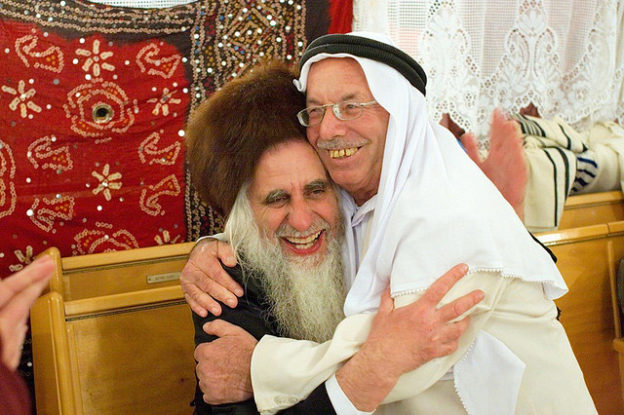
An article of mine about the negative reactions of some in the Jewish community to the release of Sholom Rubashkin and the celebrations thereof, can be read here.


An article of mine about the negative reactions of some in the Jewish community to the release of Sholom Rubashkin and the celebrations thereof, can be read here.

Agudath Israel Statement on This Morning’s U.N. General Assembly Vote
The countries that voted this morning in the United Nations General Assembly to demand that the U.S. rescind its recognition of Jerusalem as Israel’s capital and its plan to move its embassy there once again showed their true and ugly colors.
The General Assembly has long been a ludicrously anti-Israel forum, a grandiose soapbox where nations, including more than a few whose regimes routinely oppress, torture and murder their own citizens, wax righteously indignant at Israel’s audacity in defending herself against her many bloodthirsty enemies.
Today’s vote, however, forged a new low in the world body’s antipathy toward Israel. Not only does the majority of the General Assembly seek to deprive Israel of the right to determine her own capital, but it seeks to prevent our own country from respecting that right.
In 1995, Congress passed a law explicitly establishing the position of the United States that “Jerusalem should be recognized as the capital of the State of Israel,” and requiring that the American Embassy in Israel be moved to Jerusalem. Earlier this month, President Trump announced the implementation of that law.
We are proud of the steadfast friendship toward Israel and recognition of reality that Congress and President Trump have demonstrated. We applaud President Trump and Ambassador Haley for their courageous articulation of American values in the lion’s den of the United Nations.
And we remain ever hopeful that other responsible nations will come to recognize the special status of Jerusalem not only to the state of Israel but to the Jewish people throughout the millennia.

Whether one regards President Trump’s declaration that Jerusalem is the capital of Israel as a dangerous and foolhardy move or wise and deeply principled, it cast a well-deserved bucket of cold water into the faces of the Arab and European worlds. But it also begged a question: What, exactly, is “Jerusalem”?
The recent history of Eretz Yisrael is well documented. After the decline of the Ottoman Empire, the League of Nations, in 1922, granted the British a mandate to oversee “Palestine.” In November, 1947, the United Nations General Assembly approved a partition plan creating two states: one Jewish and one Arab. Jerusalem, which had by then developed well beyond the walls of the Old City, would fall under international control as a Corpus Separatum, or “separate entity.”
That never happened. The Jewish Agency for Palestine accepted the partition plan; the Arabs did not. And the following year, on the very day the British Mandate ended, the Arabs invaded the Jewish community, starting a war which, to the invaders’ surprise, they decisively lost. So, in fact – and despite what many media persist in stating – the Corpus Separatum status of Jerusalem, as part of the Arab-rejected partition plan, never became reality.
When Israel declared its independence in May, 1948, the western half of the expanded city of Jerusalem became part of the nascent state, while the eastern half, purged of its Jews, along with the Old City, was occupied by Jordan. As we all know, and some of us vividly remember, during the 1967 Six Day War, Israel rebuffed Egypt, Jordan and Syria, and captured the Golan Heights, the Sinai Peninsula, Shomron and Yehudah, including the eastern part of Jerusalem and the Old City.
The Old City. The Ir Haatikah. We sometimes forget that, while Israeli law and colloquial shprach applies the name “Yerushalayim” to the greater metropolitan area outside its walls as well, the name really refers to the Old City alone.
Chanukah is coming to an end, which, to Jews who mark time Jewishly, means that the next celebration in our sights is Purim.
And hidden in Megillas Esther, as it happens, is a passuk that holds a hint well worth pondering in the context of recent events.
“Ad chatzi hamalchus,” Achashveirosh offers Esther, “up to half the kingdom” (Esther, 5:3). The Gemara (Megillah 15b) explains that Achashverosh said “up to” in order to indicate that he was not willing to offer something in the middle of the kingdom, something that would cause a political rift were he to relinquish his control over it: the Beis Hamikdash.
We optimists hope that Mr. Trump’s recent blunt statement might, in the end, push the Arab world to come to terms with reality and actually shuffle, grumbling but surely, to the negotiation table. To fantasize further, maybe Arabs in Eretz Yisrael will be brought to see the incitement and hatred they sow as counterproductive to their goal of a state alongside Israel, and desist from their regularly scheduled vilifications of Israel and Jews.
Unlikely, certainly. But, whatever our personal feelings about whether a “two-state solution” is a healthy or a noxious prospect, it is the declared goal of both Mr. Trump and Israeli Prime Minister Netanyahu. So let’s imagine further what might emerge from such an agreement.
It really doesn’t need much imagination; the general terms of a peace agreement have long been obvious to all informed observers. Parts of Yehudah and Shomron, from which Israel’s withdrawal would not pose undue security risks, would be ceded to the Arab state. The state would be demilitarized, and pledged to abandon its hostility toward Israel.
The western part of Jerusalem would remain Israel’s capital, and the eastern part, the new state’s.
And the Old City? Oy, there’s the rub.
Would – could? – Israel cede even part of it to an Arab state? And even if it did, what about the source of the city’s kedushah, the Mekom Hamikdash?
Truth be told, Israel is not really in possession of that sacred ground even now. While she controls access to the Temple Mount, the compound is administered by the Wakf, itself controlled and funded by the Jordanian government.
That sad reality is not likely to change, not until we merit the bias go’el tzedek. Until then, though, it should be a reminder that, even were “Jerusalem” to be recognized as the capital of Israel by the entire civilized world, even by all Arab countries and a new Arab state, rejoicing would be premature. Klal Yisrael remains, l’daavoneinu, stalled in galus.
May that situation end bimheirah biyameinu.
© 2017 Hamodia

It sounds like a story about the fictional Chelm. The town philosopher sagely informs his fellow citizens that he has no face. He can’t perceive it directly, he points out, and besides, as anyone can plainly see, what people claim is his face clearly resides in his mirror.
The silly scene is inspired by celebrated scientists. Like Yale psychology professor Paul Bloom, who has lamented human beings’ stubborn commitment to “dualism,” the idea that people possess both physical and spiritual components. He pities those who believe that there is an “I” somehow separate from one’s body and brain.
“The qualities of mental life that we associate with souls…,” he asserts confidently, “emerge from biochemical processes in the brain.”
Also enlightening the backward masses is Harvard psychology professor Steven Pinker, who condescendingly advises people to set aside “childlike intuitions and traditional dogmas” and recognize that what we conceive of as the soul is nothing more than “the activity of the brain.”
Or, as they might say at the University of Chelm, since the soul seems perceptible only through the brain, the brain, perforce, must be the soul. And your stereo speakers are the music.
Sometimes, though, intuitions are right and scientific dogmas wrong. Scientists, the noted British psychologist H. J. Eysenck famously observed, can be “just as ordinary, pig-headed and unreasonable as anybody else, and their unusually high intelligence only makes their prejudices all the more dangerous.” Some, in fact, are prone to a perilous folly: the confidence – despite the long and what-should-be chastening history of science, littered with the remains of once-coddled beliefs – that they have – eureka! – arrived at conclusive knowledge.
Were the contemporary “dualism” debate merely academic, we believing Jews might reasonably choose to ignore it. Unfortunately, though, the denial of humanity’s specialness and, perforce, of our responsibility for our choices – the unmistakable ghost in the Bloom/Pinker philosophy-machine – is of substantial import.
The idea of the neshamah goes to the very heart of many a contemporary social issue. It influences society’s attitudes toward a host of moral concerns, from animal rights to the meaning of marriage to the treatment of the terminally ill.
In the absence of the concept of a human neshamah, there is simply nothing to justify considering humans inherently more worthy than animals, nothing to prevent us from considering any “lifestyle” less proper than any other, nothing to prevent us from coldly ending the life of a patient in extremis. Put starkly, without affirmation of the neshamah, society is, in the word’s deepest sense, soulless.
And the game is zero-sum: Either humans are something qualitatively different from the rest of the biosphere, or they are not. And a society that chooses to believe the latter is a society where no person has any reason to aspire to anything beyond self-gratification. A world in denial of the neshamah might craft a utilitarian social contract. But right and wrong could be no more meaningful than right and left.
The notion is hardly novel, of course. Philosophical “Materialists,” believing only in the physical and bent on despiritualizing humanity’s essence were the high priests of the Age of Reason and the glory days of Communism.
And the footsteps in which they walked were those of Yavan. The ancient Greeks hallowed reason and inquiry, and celebrated the physical world. Eratosthenes calculated the earth’s circumference to within one percent; Euclid conceived and developed geometry; Aristarchus proposed a heliocentric model of the solar system. And the early Greeks exalted the human being – but as a physical specimen, not more.
Accordingly, the most worthwhile goal of man for the Greeks was the enjoyment of life. The words “cynic,” “epicurean,” and “hedonist” all stem from Greek philosophical schools.
Which may be why the culture that was Yavan was so enraged by Klal Yisrael’s focus on kedushah. Shabbos denied the unstopping nature of the physical world; milah implied that the body is imperfect; kiddush hachodesh saw holiness where the Greeks saw only mundane periodicity; modesty, moreover, was unnatural.
The Greeks had their “gods,” of course, but they were diametric to holiness, modeled entirely on the worst examples of human beings. And Hellenist philosophers who spoke of a “soul” were referring only to the personality or intellect. The idea of a tzelem Elokim, of a neshamah that can make choices and merit eternity, indispensable to the Jew, was indigestible to the Greek.
Ner Hashem nishmas adam – “The soul of man is a Divine flame” (Mishlei 20:27). When we light our Chanukah lecht, we might keep in mind how, despite the declarations of some scientists and Chelmer holdouts, Klal Yisrael overcame Yavan not only on a physical battlefield but on a conceptual one no less.
© 2017 Hamodia

December 11, 2017
BY REGULAR MAIL & E-MAIL (consulate.newyork@mfa.gov.tr)
Honorable Ertan Yalçın
Consul General
Turkish Consulate General in New York
825 3rd Avenue
New York, NY 10022
Dear Mr. Consul General:
I write on behalf of Agudath Israel of America, a national Orthodox Jewish organization, to register outrage over the recent reported comments of Turkey’s President Recep Tayyip Erdoğan, who ludicrously called Israel – the only true democracy and humanitarian country in the Middle East – a “terrorist state” that “kills children.”
Compounding the absurdity of that charge was Mr. Erdoğan’s ahistorical assertion that “Jerusalem was ruled by Muslims for many centuries but never closed to the believers of the other religions during that time.” It is clearly documented that, at least from 1948 until 1967, Islamic authorities and Jordan prevented Jews and Christians from visiting their holy sites in the Old City, including the Western Wall. And it is well known and entirely evident that Israel provides access to all religious sites within its territory. To claim the opposite is nothing less than an attempt to create false “facts.”
Mr. Erdoğan’s further assertion that “Jerusalem is the worshipping center for mainly Muslims, Christians, and partially Jews” betrays not only further deep ignorance but even deeper prejudice.
Such baseless and incendiary rhetoric has become commonplace among barbaric enemies of peace who in fact murderously target innocents as a matter of policy. That such language now emerges from the mouth of a head of state is utterly contemptible.
Turkey for many years represented a voice of sanity and responsibility in a region cursed with delusion and violence. It is unfortunate, indeed tragic, that recent years have seen it influenced by the worst elements around it.
Sincerely,
Rabbi David Zwiebel
Executive Vice President
Agudath Israel of America
An article about an inconsistency in the heterodox Jewish movements’ attitudes appears on Tablet, and can be read here.

It wasn’t a phone call the head of the Union for Reform Judaism ever wanted to get. Taglit-Birthright was calling, with bad news.
In the U.S., the “Taglit” (“discovery”) part of the name of the non-profit organization that sponsors free ten-day trips to Israel for Jewish young adults is usually dropped; it is known simply as “Birthright.”
Founded in 1994 by two philanthropists, Wall Street money manager Michael Steinhardt and former Seagram Company chairman Charles R. Bronfman, Birthright is financed by them and other private donors, as well as by the Israeli government. More than 500,000 young people, mostly from the U.S. and Canada, have participated in the program to date.
The recent phone call was to inform the Reform leader that his movement was no longer authorized as a certified trip provider for Birthright. It wasn’t, the caller explained, because Birthright had anything against “progressive” Jewish groups, but rather a simple matter of the fact that the Reform movement had failed to meet participant quotas.
“We worked very hard with them to increase the numbers,” Birthright CEO Gidi Mark told an Israeli newspaper, “but unfortunately they could not meet our minimum.”
Although the overwhelming majority of Birthright participants come from non-Orthodox backgrounds – less than 5 percent are Orthodox Jews – Orthodox-affiliated trip providers, including the Chabad-connected group “Mayanot,” the Orthodox Union’s “Israel Free Spirit” and Aish Hatorah account for close to a quarter of total recruitment.
Birthright’s largest single donor these days is Republican supporter Sheldon Adelson. He is a promoter of the Israeli political right wing with regard to security issues and the Palestinians, but is not Orthodox. Messrs. Bronfman and Steinhardt say, “We are both secular Jews… we never saw Birthright Israel as a religious trip, though many alumni have changed their ritual practices.”
So why have Orthodox groups emerged as so disproportionate a conduit of young non-Orthodox Jews to Birthright trips?
Rick Jacobs, the president of the Union for Reform Judaism, who bemoans that fact, blames it on the Israeli government’s support for what he calls “Ultra-Orthodox campus institutions.” He also is upset that young people on Birthright trips are given the option, if they choose, to attend Orthodox services during their stay in Israel.
Reform leaders are also chagrined that, although “religious indoctrination” is prohibited on Birthright trips, the Orthodox groups also often later convince Birthright alumni to, in Rick Jacobs’ words, “explore a more traditional way of Judaism.” The horror.
Asked about Orthodox organizations’ outreach work with participants after the trips, Mr. Mark said: “We are dealing with people who are very intelligent. They are all mature people older than 18. I myself never heard any one complaint about any misuse of the relationship by our trip organizers.”
Rather than stew over the fact that nonobservant young Jews seem to gravitate to groups dedicated to “a more traditional way of Judaism” – or, put more accurately, the authentic mesorah of Klal Yisrael – Reform leaders might stop seeking culprits for that offense and consider the fact that emes, truth, is attractive.
Birthright certainly has never pushed Yiddishkeit in any way, and indeed shunned anything smacking of “religious indoctrination.”
It has helped ensure Jewish continuity by helping countless Jews connect in one or another way to their religious heritage by bringing them to Israel.
But for nearly 2000 years, visiting or settling in Eretz Yisrael was not even an option for most Jews. What sustained Jewish continuity over those millennia? Precisely Rick Jacobs’ “more traditional way of Judaism” – Jewish knowledge and Jewish living.
In fact, if Birthright really wanted to maximize its bang for the buck, it might consider dropping altogether its religious rejection of religion and consider a marvelous, gutsy move. Namely, amend Birthright’s existing program to maximize the Jewish impact of the gift it offers young Diaspora Jews, by providing them, say, for two or three of their ten days, an intensive Jewish learning experience in an Israeli yeshivah, seminary or outreach program catering to Jews from overseas.
Yes, that would violate the effort’s heretofore commitment to “pluralism.” But it would be entirely in consonance with Birthright’s professed goal, helping ensure Jewish continuity.
In fact, providing Jews who were raised distant from their religious heritage the opportunity to witness what it means to live a true Jewish life would be nothing less than, well, returning to them their birthright.
© 2017 Hamodia

Have you been following the U.S. Department of Agriculture’s advice to drink three cups of milk a day, to get enough calcium and vitamin D? No? Good for you.
Multiple studies show that there is no association between drinking so much milk (or taking calcium and vitamin D supplements) and fewer bone fractures.
Do you take a multivitamin every day? No? Good for you. Decades of research have yielded no justification for healthy people taking vitamins.
Have you at least been cutting down on coffee and keeping it from your kids, so as not to stunt their growth? No, again? Well, good for you again.
Drinking a few cups a day, it turns out, has been linked to substantial health benefits; and most research finds no correlation between children’s caffeine consumption and their bone growth.
Every generation assumes that its conclusions about scientific matters are the last word, despite the fact that they often aren’t.
Sometimes, wrong conclusions are innocent and excusable, the products of tainted data, poorly designed experiments or human error.
Other times, though, misinformation is purposely fed to the public for particular parties’ financial gain. In the case of coffee, for instance, it was villainized largely by cereal manufacturer C.W. Post, in an effort to market his “Postum” product as an alternative to what he called “nerve poison” that should never be served to children.
Enter the revelation last week about sugar. Scientists at the University of California, San Francisco, announced that they have uncovered documents demonstrating that, back in the 1960s, members of the sugar industry called off a study, named Project 259, because it linked sugar to heart disease and bladder cancer in preliminary experiments.
Last year, the same researchers discovered a document that showed the sugar industry funded a report that downplayed links between sugar and coronary heart disease.
UCSF dentist Cristin Kearns started digging into the sugar industry 10 years ago, after hearing representatives at a conference say there is “no scientific consensus” that sugar is linked to chronic illnesses. She combed through library archives across the nation and eventually came upon a box containing “confidential” documents on “Project 259.”
In 1968, the Sugar Research Foundation launched a rodent study, which measured the nutritional products of gut bacteria after rats consumed sucrose, as compared to starch.
The experiment’s early results showed that sucrose increased the poor animals’ levels of triglycerides, fatty molecules that, in humans, can clog arteries and predispose a person to heart attacks and strokes.
Another preliminary experiment in the project also found a high-sugar diet boosts the activity of an enzyme linked to bladder cancer.
After reporting this discovery in August, 1970 to the International Sugar Research Foundation, Project 259 scientists requested more time and funding to continue the research, the documents show. But the request was denied, and the project abandoned.
Dr. Kearns and UCSF cardiologist Stanton Glantz claim that the sugar industry tried to bury the evidence and stopped the project because of the negative findings.
A sugar industry spokesperson dismissed that claim as “a collection of speculations and assumptions about events that happened nearly five decades ago.” It also called the researchers “known critics of the sugar industry.” Glucophobics, as it were.
In 2004, a trial revealed that tobacco industry officials had intentionally deceived Americans for years into thinking that smoking did not cause cancer, despite having clear evidence to the contrary.
No trial is in the works at present for Big Sugar, but the parallel is there. Sugar might not smell bad or turn teeth yellow. But too much of it can, over time, be deadly.
The recent report isn’t the first to reveal the sugar industry’s machinations, either.
According to an analysis of historical documents published in the journal JAMA Internal Medicine, when studies first began linking sugar with heart disease, a sugar industry group paid Harvard researchers to write an article about the issue.
Published in 1967, it played down the effects of sugar and concluded that the only dietary intervention needed to prevent heart disease was reducing cholesterol and saturated fat. Which led to the decades-long, aggressive marketing of an assortment of “low fat” products – that, incidentally, contained more sugar than their regular counterparts.
The American Heart Association recommends that men consume less than 150 calories of added sugar per day; and women, less than 100.
There are 16 calories in a teaspoon of sugar. A 12-ounce can of regular soda contains about 9 teaspoons of sugar.
Do the math. And, remembering the Torah’s exhortation to guard our health, do the right thing for your health.
© 2017 Hamodia

My brother, a rebbe in Yeshivas Ner Yisroel’s Mechina high school, and his wife, the daughter of the legendary Menahel Rav Yosef Tendler, z”l,were recently blessed with two new grandsons. Both were named Simcha Bunim, after my father, hk”m, whose first yahrtzeit will be observed on 20 Kislev.
When I wished my brother and his wife “veiter simchos!” – “further happy occasions! – I wondered if I had inadvertently uttered a double entendre. It turns out I did. My wife and I just returned from Milwaukee, where another bris took place, as our daughter and son-in-law welcomed their new little boy to their family; he, too, is a Simcha Bunim.
I’ve been thinking, as you might imagine, about the name.
Firstly, what exactly is “Bunim”? My father always assumed that it derived from Binyamin, and there are sources that indeed assert that. But another possibility was suggested to me by a brother-in-law’s brother, Tzvi West, who thinks (very plausibly, to me) that, like many double names (e.g. Zev Wolf, Dov Ber, Aryeh Leib…), “Simcha Bunim” may be a vernacular translation added to a Hebrew one. Because, in French, bonhomme means “a good-natured man” or “a man of good cheer.”
If that theory is right, though, both names are uncannily descriptive of my father.
He was renowned for his ready, radiant smile, and over the more than sixty years he served as a shul Rav, countless congregants and strangers alike were greeted with his sever panim yafos. He was a reservoir of friendly, encouraging words for all who sought his counsel.
But simchah isn’t only an interpersonal ideal. We exist for avodas Hashem. And Dovid Hamelech reveals that our lifelong service be done with simchah – ivdu es Hashem bisimchah. Jewish joy occupies a very high plane indeed.
I don’t know if my father was able to embrace simchah as he fled as a young teen with his family from their Polish town before the invading Nazis in 1939, or when he saw his uncle shot dead before him, or when he and other Jews were locked in a shul that was set aflame (though I imagine he must have smiled when a German army officer – Eliyahu Hanavi, the Jews suspected – passed by and ordered the Jews released). Or if he attained moments of joy during the years he and his Novardok chaverim spent as the guests of the Soviets in a Siberian work camp. But knowing Norvardok’s stress on making the most of every moment of life, it’s entirely plausible.
What I know for fact, though, is how Simchas Torah was his Yom Tov. He rejoiced then with vigor that left anyone who witnessed it astonished. And how delighted he was during his long career to be able to provide a spiritual home for a congregation of Yidden of widely diverse backgrounds and levels of observance.
When my siblings and I were young, it didn’t occur to us that a Rav davening all the Yamim Noraim tefillos (and blowing the shofar) himself was unusual. When, eventually, he trained others to daven for the amud, he took great joy in that, too, and always happily encouraged the new baalei tefillah.
He also undertook the most menial tasks of maintaining a shul with joy. The shul had no shamash, only a rabbi who saw honor in every shul chore.
A congregant recounted seeing him in the shul perched on a 20-foot ladder, changing a light bulb.
“What are you doing?” the man asked him. My father looked down and, wondering at the question, said, “changing a bulb.”
“I know. But why are you doing it?”
“Because the old one burned out,” he explained patiently, with his characteristic smile.
Leaving a neighbor’s shivah house five or six years ago, I was stopped by a gentleman who said he recognized me from a recent chasunah we had both attended, of a relative of mine (the man had a connection to the other family). I confirmed I had indeed been there. He then he took out his phone and said “I have to show you a short video from that chasunah. This zaken was dancing so gracefully, like a young bachur!”
My suspicion of what might be coming was borne out. The video was of my father, well into his 80s at the time, being mesame’ach the chassan and kallah with vigor and joy.
At present, he has five little boy descendants who carry his name (and one little girl who was named Simcha). May they, and, be”H, veiter simchos, herald a new infusion of joy into our world.
© 2017 Hamodia

Below is my original draft of a piece I wrote for Forward. The article as it appeared there, though, was substantially edited, and several sentences that I think are important were omitted. So I share the original here. The Forward piece can be read here.
Well, in case anyone for some reason may have been wondering, Peter Beinart, who recently wrote a piece titled “The Orthodox Should Know Better than to Embrace Hatred of Muslims,” doesn’t follow J.K Rowling on Twitter.
Because if the Forward senior columnist and former The New Republic editor did, he would have seen Harry Potter’s creator’s retweet last year of a haredi (or in the Forward’s pejorative preference, “ultra-Orthodox”) rabbi’s message.
The rabbi shared the fact that he had dedicated his presidential election vote to the American Muslim soldier Captain Humayun Khan – who was killed in combat and about whom his father Khizr spoke movingly at the Democratic National Convention. Then-candidate Donald Trump, of course, was then touting his “Muslim ban.”
The Hasidic rabbi, who serves as a media relations coordinator at the national Orthodox Jewish organization Agudath Israel of America (full disclosure: I work there too), shared a photo of himself holding his ballot, alongside a photo of Captain Khan and his gravestone. He wrote that he wanted to highlight how Captain Khan’s “devotion makes (religious) freedom possible.”
The tweet was liked almost 12,000 times and retweeted 5,496 times, including Ms. Rowling’s sharing of the photo and message with her 13 million followers. Not one of whom, apparently, is Mr. Beinart, who wrote recently here that “the inability to distinguish jihadist terrorism from Islam fuels American Jewish hostility toward American Muslims” and that such inability is “particularly true among the Orthodox.”
Mr. Beinart must have also missed the story of the haredi director of a Brooklyn soup kitchen who, after the election, rallied support within his community for Muslim Yemeni neighbors who were protesting the new president’s executive order banning immigration from seven Muslim-majority countries. The haredi also organized support for a beleaguered local Yemeni-owned bodega, complete with “Shalom/Salaam” posters.
Agudath Israel, moreover, issued a pro-immigration statement about the ban asserting that such a move is acceptable only if intended to prevent terrorists from entering the country, only “if tempered by true concern for innocent refugees” and only if “its focus is on places,… not on religious populations.”
Mr. Beinart could be forgiven for not knowing about the hassidic WhatsApp group that calls itself “Isaac and Yishmoel,” created to enable its members to defend unfairly maligned Muslims.
But some research on his part might have turned up the fact that Agudath Israel’s executive vice president chairs the Committee of New York City Religious and Independent School Officials, which includes representation from the Islamic School Association. And that he has worked with Islamic school representatives on a number of issues before the New York State Education Department. And that, on the national level, he works with Islamic school groups under the umbrella of the Council for Private Education.
Agudath Israel has also joined with Islamic groups in amicus briefs in religious liberty cases, and, along with the Orthodox Union, another major national group, has opposed “anti-sharia” laws.
Is there wariness about Muslims among many Orthodox Jews? Yes, as there is among many non-Orthodox ones, among many Episcopalians, Catholics and Hindus too. Is that fair to the vast majority of Muslim citizens, who have no evil designs? No. But, unfortunately, the proclaimed world-conquering designs of Islamists and the malevolent acts committed by extremists exist. The distrust that results is, unfortunately, the responsible Muslim’s unfair burden to bear.
But do Orthodox Jews hate Muslims or seek to harm them? Mr. Beinart should visit one of the Brooklyn neighborhoods where Orthodox Jews and Muslim immigrants live side by side, day by day without friction.
The Forward columnist compounds his slander of Orthodox Jews by engaging in some Orthophobia, in effect accusing haredim of preventing women from marrying, touting genocide and killing babies. Yes, you read right.
There isn’t space here to rebut such outlandishness. Suffice it to say that it is a high haredi ideal to find ways to compel a recalcitrant husband to agree to divorce his abandoned wife; that no people today can be identified with Amalek, and so the biblical injunction to destroy that evil nation cannot be applied; and that metzitza bipeh, the oral suction practiced by some haredim as part of the Jewish circumcision rite, has never been proven to be related to, much less the cause of, any infection in an infant, as three medical/statistics experts have affirmed (http://forward.com/opinion/letters/194118/no-conclusive-evidence-on-circumcision-rite-and-he/) in these very pages.
The Orthodox community’s final crime, in the Beinart courtroom, is having voted in large numbers, and in contrast to the larger Jewish community, for the man currently occupying the White House. Judge Beinart chooses to interpret that fact as the result of Orthodox anti-Muslim sentiment.
Might it be, though, that many haredim simply recognize that judicial appointments comprise one of the most influential powers any president has? And felt that Mr. Trump’s likely choices would prove more sensitive to our community’s concerns about societal issues and the potential erosion of religious rights in America?
We must plead guilty – forgive us – to the charges of being social conservatives and religious rights activists. But not to Mr. Beinart’s ugly and incendiary charge.